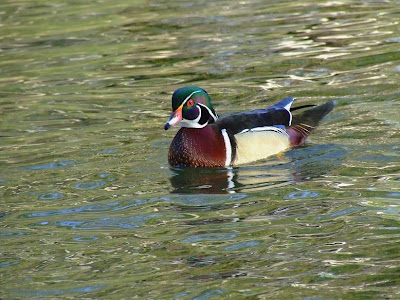
This winter has produced higher than normal numbers of sapsuckers in Orange County. Normally, only a handful of Red-naped Sapsuckers are found every year; this year, I alone have seen at least eight different individuals in Orange. Red-breasted Sapsuckers, the most expected sapsucker species, have also been quite common (I saw one out my bedroom window a couple days ago). Today, I found a third species: a Yellow-bellied Sapsucker! I saw it at Santiago Oaks Regional Park.
The whole story behind this sapsucker is rather bizarre. Back in late December, it was rumored that someone had seen four Yellow-bellied Sapsuckers at Santiago Oaks Regional Park. Naturally, no one believed it. One Yellow-bellied Sapsucker would be extraordinary - let alone four! I went sapsucker hunting there in January, and found only a single Red-naped. Case closed, I thought, until Bob Scrimger emailed me a beautiful photo of an obvious Yellow-bellied Sapsucker that he had seen a week ago at Santiago Oaks Regional Park. As I pedaled over there this afternoon, I wondered why no one had reported to OrangeCounty Birding; other birders had definitely seen it, and it had been seen all winter. Things like this frustrate me to no end; oftentimes I'll read in the "Sightings" section of the Wandering Tattler (Sea & Sage Audubon's newsletter) about some rarity that was seen, but never reported. I, of course, can understand some situations in which a bird shouldn't be reported, like a rarity in a private backyard. However, all too many of these rare birds are seen at public parks and the birders just don't report them. Grr.
As I rolled into the park, the prospects didn't look good. A tree-trimming company was butchering some trees around the parking lot (where the bird was supposed to be), and bird activity was low. Still, I found some Hutton's Vireos and a very handsome Northern (Red-shafted) Flicker. I also noticed this rabbit crouched under some bushes nearby.

After I had wandered around a bit, the chainsaws and chippers were silenced. Suddenly, birds seemed to be everywhere. No sign of any sapsuckers, however. As I was circuiting the lot for the second time, I noticed a couple pepper trees up on a slope nearby. My strategy for finding sapsuckers is simple: find pepper trees, and look in them. I crossed the creek, and managed to find the trees. One of them was riddled with sapsucker holes and -- THERE!! Hanging ten feet above the trail on the underside of a branch was a sapsucker. Peering through my binoculars, I could see the classic Yellow-bellied Sapsucker field marks: a whitish nape, with no red; fairly wide white lines on the face; no red on the auriculars; full black frame around the red throat; and fairly messy back pattern. It had lots of wells in the pepper tree, and a few in a nearby willow as well. Here's a zoomed in shot, showing the head pattern:

The bird was wary, and after I had watched it for several minutes and taken a few photos it flitted away. As I was walking back to my bike, I spotted a couple Sara Orangetips (Anthocharis sara) fluttering around. A life butterfly for me!

In the parking lot, while unlocking my bike, a little female Selasphorus hummingbird (Allen's is most likely) landed in a bush just feet away. I fumbled with my camera and snapped off one shot before she zoomed off.

I set out for Irvine Regional Park to try to find Red-naped and Red-breasted Sapsuckers to make it a three-sapsucker day. Oddly, I couldn't find either. While searching for the elusive Red-breasted Sapsucker near parking lot six, I heard an oddly familiar chattering noise coming from a nearby tree. I looked - a gorgeous male Hooded Oriole! It seemed early - sure enough, it was, according to the San Diego County Bird Atlas. It says they are rare in early March and become common by late March. After giving up on the sapsuckers, I visited the Lewis's Woodpecker. I immediately saw a large birding sitting atop the woodpecker's snag - a Merlin. Bad news for the woodpecker, I thought, as I jogged up for a closer look. However, after the Merlin took off, the Lewis's Woodpecker popped out of the shadows on the opposite side of the trunk where it had been sitting motionless. Smart bird!
As I rode by the lake, I couldn't help but notice the ducks in the lower lake; about a half-dozen Ring-necked Ducks, the single female Lesser Scaup, several Wood Ducks, and of course lots of Mallards. All were very cooperative as soon as I bribed them with granola bar crumbs.

I was also excited to finally get some half-way decent shots of a drake Wood Duck. I've been trying since last June! All of my previous shots were either out of focus, in bad light, or blocked by the obnoxious Mallards.


All in all, a very productive day of birding. Yellow-bellied Sapsucker was a county bird; Hooded Oriole and Yellow-bellied Sapsucker were new year/Bigby birds; the Lewis's Woodpecker and Merlin are always cool to see; and I was happy to get some decent duck photos.
1 comment:
"Life butterfly." *rolls eyes*
Post a Comment